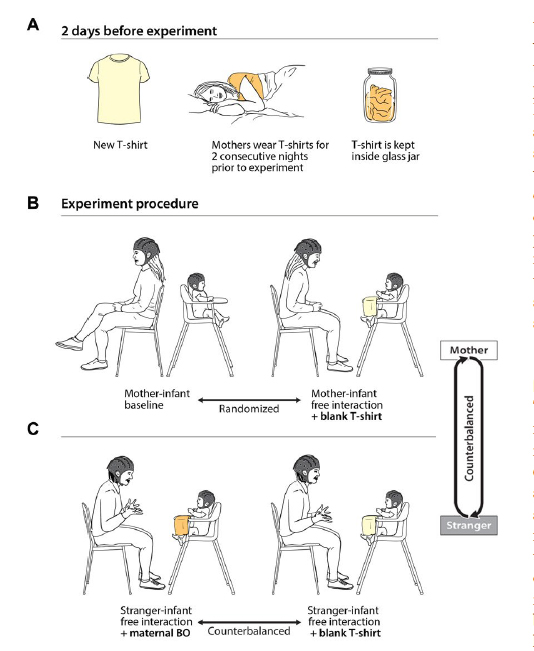I wrote the other day about the effects of “chemosignals,” scents or odors from a newborn's scalp on aggression by their mothers and fathers. This study looked at the response to maternal odors.
We, humans, are social creatures, and much of our underlying humanness comes from mimicking and synchronizing with the behavior and physiological rhythms of others in our tribe. Mirror neurons that fire when we see particular actions and help develop empathy, the synchronicity of our heartbeats when we hear a story, or the convergence of menstrual cycles among groups of women are all examples of factors underlying our social ways. Infants are drawn to faces and eyes. Gazing into the eyes of an infant promotes synchronicity of brain waves between mother and baby – the Vulcan mind-meld, if you will. That coupling enhances the mimicking of adult behavior and becoming an integrated social creature. The research looked at the role of maternal body odor in that process of synchronization.
 The study itself was rather straightforward. Brain waves of both the adults and babies were captured using EEGs. The synchronicity of the waveforms was captured with mother and baby looking eye-to-eye and back-to-back. In the second series of experiments, the EEG of a woman looking very similar to the mother (the stranger) and the baby were captured again, looking eye-to-eye. But in one instance, the stranger wore a t-shirt worn by the mother for two days, in the second instance a “blank” t-shirt.
The study itself was rather straightforward. Brain waves of both the adults and babies were captured using EEGs. The synchronicity of the waveforms was captured with mother and baby looking eye-to-eye and back-to-back. In the second series of experiments, the EEG of a woman looking very similar to the mother (the stranger) and the baby were captured again, looking eye-to-eye. But in one instance, the stranger wore a t-shirt worn by the mother for two days, in the second instance a “blank” t-shirt.
Sixty-two dyads of biological mothers and infants (around seven months in age) completed the eye-to-eye segment, 39 completed the back-to-back segments, 51 dyads completed the stranger experiments. The infants were roughly even in gender. The t-shirt was worn for two consecutive nights, and the donors asked not to use any fragrances, i.e., soap, deodorants, shampoo, or conditioner. The t-shirts were stored in a glass jar. EEG synchronicity was based on theta waves which are most strongly associated with emotional and behavioral cueing – for infants increased theta is associated with increased attention. [1]
The researchers found that
- Theta synchronicity was greater between the mother and child when eye-to-eye rather than back-to-back
- Theta synchronicity was far less between the stranger and child until the stranger put on that maternal t-shirt. Then the synchronicity was essentially the same as that of the baby with the mother.
- In reviewing the videotapes made during the interactions, the researchers found that wearing that maternal t-shirt increased the baby’s visual attention to the stranger, their overall activity or arousal, and infant “approach and engagement” measures of feeling safe. Only the moments of visual attention increased theta synchronicity.
If it takes a village to raise a child, it evidently begins with the village sharing chemosignals (a term that sounds better than body odors). Additionally, Eye-to-eye contact is clearly essential to our socialization. It is intriguing that when we feel shame, we do not look directly in the eyes of those we are speaking with and that the phrase “look me in the eye and say that” signals greater veracity in direct eye-to-eye content while speaking.
The bonding between mother and child is reflected not only emotionally but physiologically. That synchronicity extends over time to other members of our tribe, which seems to be an underlying force that makes us social creatures. Whether odor plays a similar role as we grow older remains an open research question. But like the study of odors released from an infant’s head, it suggests that humans can respond to pheromones.
The right hemisphere hypothesis is a theory that our emotional, holistic, intuitive thoughts arise primarily in our right side; while the left hemisphere gives rise to more linear, analytic thinking. In this study, the synchronicity seen in the mothers, infants, and strangers all occurred on the right "emotional" hemisphere . And it seems that the right hemisphere is the more dominant of our two, at least during the first few years of life. The right hemisphere is also more visual and able to grasp the whole of things. You can read a bit more about this hypothesis and the effect of our current media on our adult thoughts here.
We are genuinely wonderous complex creations irrespective of who or what you believe is our origins.
[1] The electrical activity of the neurons within our brain are captured in waveforms on an EEG or electroencephalogram. They are classified by their frequency. Theta waves at a frequency of 4-7.5 Mhz are relatively slow, although faster than Delta waves associated with sleep.
Source: Maternal chemosignals enhance infant-adult brain-to-brain synchrony Science Advances DOI: 10.1126/sciadv.abg6867




